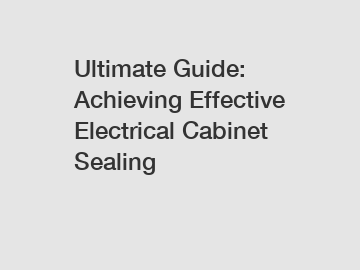Ultimate Guide: Achieving Effective Electrical Cabinet Sealing
Electrical cabinet sealing is a crucial aspect of ensuring the safety and proper functioning of electrical installations. Whether you are an industry professional or a homeowner managing your electrical setup, achieving effective cabinet sealing is of utmost importance. In this comprehensive guide, we will delve into the key factors and best practices that ensure optimal results in electrical cabinet sealing.
1. Understanding the Importance of Effective Electrical Cabinet Sealing:
Electrical cabinets are exposed to various elements such as dust, moisture, and temperature fluctuations. Inadequate sealing not only compromises the performance of electrical components but also poses safety risks. Identifying the potential hazards associated with subpar sealing will help you appreciate the significance of this task.

2. Material Selection:
Choosing the right sealing materials is vital. There is a wide variety of materials available, including gaskets, adhesives, and heat-shrink tubing. Factors such as the degree of exposure to liquids and chemicals, UV resistance, temperature resistance, and electrical insulation properties need to be considered when making the appropriate selection.
3. Conducting a Thorough Cabinet Inspection:
Before initiating the sealing process, thoroughly inspect the electrical cabinet. Identify any existing damage or cracks that may compromise the seal. Remove debris, clean the cabinet, and repair any damages before proceeding.
4. Preparing for Sealing:
To achieve a successful seal, ensure the cabinet is dry and clean. Remove any traces of old sealants or gaskets, as they may hinder the adhesive properties of the new material. It is highly recommended to follow the manufacturer's instructions for surface preparation and compatibility.
5. Proper Installation of Sealing Materials:
Adhering to the manufacturer's guidelines is crucial for effective sealing. Pay attention to the recommended thickness of the sealing material and ensure a snug and even fit along all edges and seams. Apply additional layers or adjust the material as necessary, taking extra care around cable entry points, HVAC openings, and hinges.
6. Sealant Compatibility with Electrical Components:
Certain sealants can degrade the performance of electrical components due to their chemical composition. Therefore, it is important to select sealants that are compatible with the specific environment and components within the electrical cabinet. Consult with experts or refer to product datasheets for accurate information.
7. Protection Against Dust and Contaminants:
Dust and other contaminants can accumulate within an electrical cabinet, interfering with the functionality of sensitive equipment. Securely sealing all cable entry points and openings is vital to prevent dust ingress. Utilize cable glands and brush strips to minimize the risk of dust contamination, while still maintaining ease of cable management.
8. Ensuring a Reliable Moisture Barrier:
Moisture is a common enemy of electrical systems, making a reliable moisture barrier an indispensable part of the sealing process. Waterproof sealants, gaskets, and moisture-resistant materials are essential for protecting delicate electrical components from exposure to water, condensation, or humidity.
9. Regular Maintenance and Inspection:
Even with proper initial sealing, continuous maintenance and inspection are essential. Regularly monitor the condition of seals, gaskets, and other sealing materials to detect any potential deterioration or damage. Conducting periodic maintenance will help identify and address issues before they lead to larger problems.
Conclusion:
Effective electrical cabinet sealing is a critical requirement to ensure the safety, functionality, and durability of electrical installations. By understanding the importance of proper sealing, selecting the right materials, and following best practices during installation, you can create a reliable and long-lasting seal. Regular maintenance and inspection will ensure ongoing protection against environmental factors. Remember, investing time and effort in achieving effective electrical cabinet sealing will pay off in the form of enhanced safety and optimized performance.
If you want to learn more, please visit our website enclosure cabinet sealing strip supplier, Industrial Sealing Profiles, epdm rubber strips.


